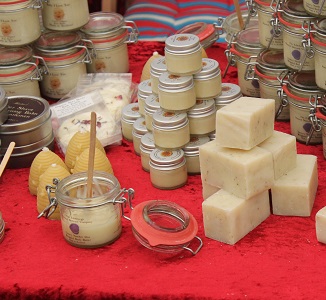 When bees collect pollen and nectar from flowers and bring it back to the hive – some of it is converted into honey but the rest is converted into beeswax. Bees build their combs from beeswax so they need it in order to survive.
When bees collect pollen and nectar from flowers and bring it back to the hive – some of it is converted into honey but the rest is converted into beeswax. Bees build their combs from beeswax so they need it in order to survive.
Once you see white cappings in the hive covering the hexagonal shaped cells, it means that the honey is ready for extraction. It is the cappings which are situated on both sides of the cells that make up the beeswax.
The cappings are removed from both sides of the cells and set aside to max wax blocks and the honey is then readily extracted from the cells.
Bees wax is great for making many things, including:
- Candles
- Furniture polishes
- Leather polish
- Wax printing on cloth
- Waterproofing thread
- Hoof conditioners for animals
Combs may be rendered into wax blocks – newer combs produce the best quality wax. Older combs contain propolis and also waste residue such as old cocoons – this makes it a less desirable wax.
Interesting fact: Bees’ wax has a high melting point when compared to other types of wax 64 degrees C.
Most methods of rendering wax use hot water to melt it. They are based on the fact that beeswax floats in water. A few words of caution are in order, however:
- Place the honey comb into a large, steel, aluminium or enamelled pot filled with cold water.
- Place it on a stove and heat the water until the wax is melted – DO NOT boil the water vigorously as the wax is flammable; vigorous boiling also produces a brittle, lower quality wax.
- Strain the wax and water through a screen into another container.
- When the water cools the wax will harden on top of the water.
- Remove the wax.
- There will be some residue on the bottom of the wax – scrape this off until you reach clean wax.
- Store the wax blocks in sealed (e.g. snap-lock) plastic bags.
- You can reheat the wax and use it as desired e.g. pour it into mould etc.
Hints:
- Render the combs into blocks as soon as possible after honey extraction – as the combs age they are susceptible to damage by wax moths.
- Store un-rendered combs in sealed plastic bags along with moth balls and check often to ensure there is no deterioration from moth larvae.
- Bees wax will absorb chemicals – keep away from pesticides etc. has they can contaminate the wax and it will be no longer useful as a comb foundation.
- Always use steel, aluminium or enameled containers when processing bees wax other metals e.g. copper may discolour the wax.

An extract from a forthcoming short course being developed by our staff -Watch out for it on this site in September/October 2016